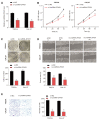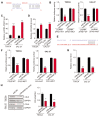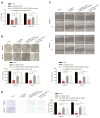Long Noncoding RNA ZFAS1 Promotes Progression of Oral Squamous Cell Carcinoma Through Targeting miR-6499-3p/CCL5 Axis
- PMID: 34697152
- PMCID: PMC8627759
- DOI: 10.21873/invivo.12616
Long Noncoding RNA ZFAS1 Promotes Progression of Oral Squamous Cell Carcinoma Through Targeting miR-6499-3p/CCL5 Axis
Abstract
Background: Oral squamous cell carcinoma (OSCC) ranks sixth among malignancies in the world, and there are 200,000 new cases annually, rendering OSCC a significant global public health issue that has caused great burdens on patients, society, and the economy. Despite great progress in diagnosis and treatment methods, patient survival has not been greatly enhanced. Hence, there is an urgent need to identify novel targets that can serve as early diagnostic and therapeutic biomarkers for OSCC. Long non-coding RNAs (lncRNAs) participate in several cancer types, including OSCC. This work identified the competing endogenous RNA network related to lncRNA zinc finger nuclear transcription factor, X-box binding 1-type containing 1 antisense RNA 1 (ZFAS1) in OSCC, as well as the corresponding downstream targets.
Materials and methods: Firstly, we identified the lncRNA ZFAS1 levels in OSCC cells and tissues and confirmed its relationship to tumor progression. Secondly, we identified a lncRNA-miRNA-mRNA network, which was closely associated with OSCC development using bioinformatics methods. Next, our hypothesis that lncRNA ZFAS1 modulates OSCC progression was verified with in vitro and in vivo experiments.
Results: Firstly, we found lncRNA ZFAS1 expression increased within OSCC cells and tissues and was positively associated with tumor progression. Secondly, its lncRNA-miRNA-mRNA network was determined, and the target of ZFAS1 was identified as miR-6499-3p/C-C motif chemokine ligand 5 (CCL5). Mechanistically, we found that ZFAS1 up-regulated CCL5 by competitively sponging miR-6499-3p. Further studies demonstrated that ZFAS1 promoted tumor progression in vivo and in vitro.
Conclusion: Our results indicate that ZFAS1 serves as a crucial oncogenic factor in OSCC occurrence and development and may therefore serve as a possible therapeutic target for OSCC.
Keywords: CCL5; Oral squamous cell carcinoma; ZFAS1; ceRNA; lncRNA.
Copyright © 2021 International Institute of Anticancer Research (Dr. George J. Delinasios), All rights reserved.
Conflict of interest statement
The Authors declare no competing financial interest.
Figures





Similar articles
-
lncRNA TUG1 promotes the development of oral squamous cell carcinoma by regulating the MAPK signaling pathway by sponging miR-593-3p.Cell Cycle. 2022 Sep;21(17):1856-1866. doi: 10.1080/15384101.2022.2074624. Epub 2022 May 23. Cell Cycle. 2022. PMID: 35604743 Free PMC article.
-
Long non-coding RNA LINC01137 contributes to oral squamous cell carcinoma development and is negatively regulated by miR-22-3p.Cell Oncol (Dordr). 2021 Jun;44(3):595-609. doi: 10.1007/s13402-021-00586-0. Epub 2021 Apr 2. Cell Oncol (Dordr). 2021. PMID: 33797737
-
Oncogenic Role of ZFAS1 lncRNA in Head and Neck Squamous Cell Carcinomas.Cells. 2019 Apr 21;8(4):366. doi: 10.3390/cells8040366. Cells. 2019. PMID: 31010087 Free PMC article.
-
Novel insights on oral squamous cell carcinoma management using long non-coding RNAs.Oncol Res. 2024 Sep 18;32(10):1589-1612. doi: 10.32604/or.2024.052120. eCollection 2024. Oncol Res. 2024. PMID: 39308526 Free PMC article. Review.
-
Review of Disease-Specific microRNAs by Strategically Bridging Genetics and Epigenetics in Oral Squamous Cell Carcinoma.Genes (Basel). 2023 Aug 2;14(8):1578. doi: 10.3390/genes14081578. Genes (Basel). 2023. PMID: 37628629 Free PMC article. Review.
Cited by
-
Non-Coding RNAs: Foes or Friends for Targeting Tumor Microenvironment.Noncoding RNA. 2023 Aug 28;9(5):52. doi: 10.3390/ncrna9050052. Noncoding RNA. 2023. PMID: 37736898 Free PMC article. Review.
-
Novel miRNA markers and their mechanism of esophageal squamous cell carcinoma (ESCC) based on TCGA.Sci Rep. 2024 Nov 8;14(1):27261. doi: 10.1038/s41598-024-76321-0. Sci Rep. 2024. PMID: 39516222 Free PMC article.
-
Comprehensive analyses of mitophagy-related genes and mitophagy-related lncRNAs for patients with ovarian cancer.BMC Womens Health. 2024 Jan 13;24(1):37. doi: 10.1186/s12905-023-02864-5. BMC Womens Health. 2024. PMID: 38218807 Free PMC article.
-
Long Non-coding RNA ZFAS1 Regulates Fibrosis and Scortosis in the Cell Model of Diabetic Nephropathy Through miR-525-5p/SGK1 Axis.Appl Biochem Biotechnol. 2024 Jul;196(7):3731-3746. doi: 10.1007/s12010-023-04721-5. Epub 2023 Sep 28. Appl Biochem Biotechnol. 2024. PMID: 37768477
-
Smoking and alcohol specific alterations in miRNA expression in head and neck squamous cell carcinoma.Discov Oncol. 2025 Aug 2;16(1):1458. doi: 10.1007/s12672-025-03308-2. Discov Oncol. 2025. PMID: 40751766 Free PMC article.
References
MeSH terms
Substances
LinkOut - more resources
Full Text Sources
Medical
